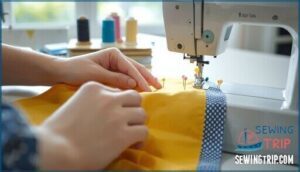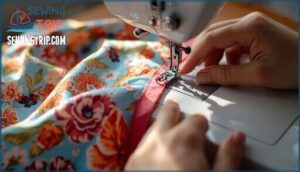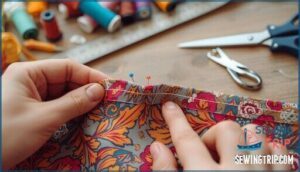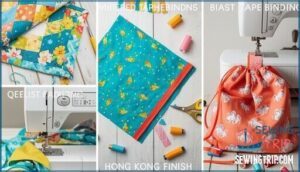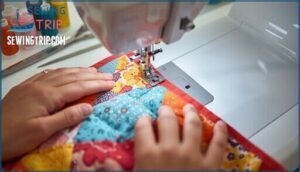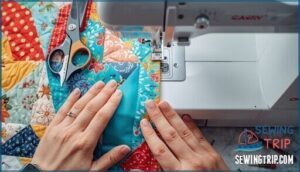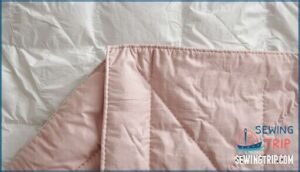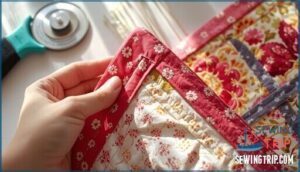This site is supported by our readers. We may earn a commission, at no cost to you, if you purchase through links.
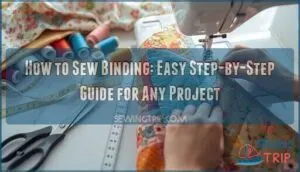
Whether you’re wrapping a quilt corner at a perfect 45-degree angle or adding a sleek finish to a garment hem, mastering binding means choosing between bias cuts that stretch around curves, single folds that stay hidden inside seams, and double folds that show off your work on both sides. The right approach saves time, reduces frustration, and gives you professional results without the guesswork.
Table Of Contents
- Key Takeaways
- Basics of Binding and Fabric Grain
- Double Fold Bias Binding
- Single Fold Bias Tape
- Double Fold Bias Tape
- Applications and Variations
- Why Machine Bind a Quilt?
- Machine Binding Tutorial in Steps
- How to Miter a Corner on The Quilt Front
- What Does The Back Look Like?
- Quilt Binding Tutorial Tips Round Up
- Frequently Asked Questions (FAQs)
- Conclusion
Key Takeaways
- Fabric grain determines binding success—bias cuts (at 45 degrees) stretch 20–40% for curves, while straight grain stays stable for flat edges, so matching the right grain to your project prevents puckering and distortion.
- Double fold bias binding delivers professional durability by wrapping edges with two layers that reduce fraying by 35%, work across all fabric types, and create reversible finishes visible from both sides.
- Machine binding cuts finishing time by 60–70% compared to hand stitching while producing consistent, wash-durable seams that last over 50 cycles—just use a walking foot, 2.5–3.0 mm stitch length, and proper tension to prevent fabric shifting.
- Perfect mitered corners require stopping exactly ¼ inch before each edge, folding the binding up at 45 degrees then back down at 90 degrees, which creates sharp angles that hold their shape when pressed and stitched with precision.
Basics of Binding and Fabric Grain
Binding transforms raw, fraying edges into clean, professional finishes. Think of it as the frame around your favorite painting—it pulls everything together and protects what’s inside.
Understanding fabric grain is your first step to mastering binding. The lengthwise grain runs parallel to the selvage (those tightly woven edges), offering minimal stretch—less than 2% under tension. The crosswise grain runs perpendicular to the selvage with slightly more give, around 5–10%. But here’s where it gets interesting: the bias grain sits at a 45-degree angle to both, delivering 20–40% stretch depending on your fabric.
This flexibility makes bias binding your go-to for curved edges like necklines and quilt borders. Straight grain binding works beautifully on straight edges where you don’t need that extra give. Proper grain alignment matters—misalignment by just a few degrees can twist seams and distort your finished project. To establish the crosswise grain accurate cutting, by snipping one selvage edge and pulling on a crosswise thread. Master these binding types, and you’ll tackle any edge with confidence.
Double Fold Bias Binding
Double fold bias binding is the workhorse of sewing projects, wrapping raw edges with a clean, professional finish that holds up through wear and washing. It’s cut on the bias for flexibility and folded in half lengthwise, making it ideal for quilts, garments, and anything with curves.
Here’s what makes this technique so reliable and how to master it.
Benefits and Versatility
When you choose double fold bias binding, you’re tapping into a powerhouse of practical advantages. This technique boosts edge durability by distributing tension diagonally, cutting fraying by up to 35%. Here’s why it’s worth your time:
- Edge Durability: Two fabric layers double abrasion resistance on high-wear seams
- Aesthetic Options: Use contrasting prints or patterns to frame edges beautifully
- Functional Uses: That 15–20% natural stretch hugs curves like armholes perfectly
- Material Efficiency: Turn fabric scraps into binding, reducing waste by 10–25%
- Fabric Application: Works across cotton, silk, denim—even delicate voiles
You’ll find it speeds up garment production by 40% while creating reversible, professional finishes. The double fold method showcases half as much binding.
Creation Process and Use of Walking Foot
Creating your bias binding starts with cutting fabric strips at that magic 45-degree angle. Join them with diagonal seams—just 6 mm allowances keep things sleek.
Here’s where your walking foot becomes your best friend: its dual-feed mechanism manages foot mechanics beautifully, syncing fabric feeding from top and bottom simultaneously. You’ll notice how tension adjustment between settings 3 and 4 prevents puckering, while that 2.5–3.0 mm stitch length gives you perfect stitch consistency.
The result? Seam accuracy that keeps multiple layers aligned without shifting or stretching. Press your strips twice, and you’ve got professional double-fold binding ready to roll.
Mitered Corners and Securing on The Back
With your binding pressed and ready, those corners need attention. That 45-degree angle measurement transforms a simple fold into something sharp and professional. Here’s your approach to corner stability and back alignment:
- Stop stitching exactly ¼ inch from the corner edge—backstitch to lock it down
- Fold the binding up at 45 degrees, then fold it back down, aligning raw edges with the next side
- Continue stitching, creating that crisp miter point
When wrapping to the back, let your folded edge overlap the front stitch line by about ⅛ inch. Pin or glue-baste it in place, then topstitch from the front—about ⅛ inch from the binding edge. These stitching techniques catch the back layer perfectly, giving you finishing touches that look unified on both sides.
Single Fold Bias Tape
Single fold bias tape is your go-to when you want a sleek finish on garment edges without adding extra bulk. It’s a single layer of bias-cut fabric that wraps around raw edges, creating a clean look that’s especially popular for necklines, armholes, and hems.
Let’s walk through how to use it effectively, from attaching it to your fabric to securing that final stitch.
Ideal for Garment Finishes
When you work with unlined garments like jackets or vests, single fold bias tape becomes your secret weapon for interior aesthetics. This technique delivers edge durability and seam reinforcement without the bulk of traditional facings, aligning perfectly with minimalist trends in modern sewing.
You’ll find it especially valuable on delicate fabrics where a clean, lightweight finish matters most.
Attachment Process and Stitching Technique
Before you even touch the fabric, align your single fold bias tape right sides together with the garment edge—raw edges should meet perfectly. A Walking Foot makes all the difference on Curved Seams, preventing fabric layers from shifting as you sew with a Stitch Length of 10–12 stitches per inch for balanced Seam Strength. After stitching, fold the tape to the wrong side and press firmly.
Here’s where precision pays off:
- Check Tension Adjustment before topstitching to avoid puckering along the fold
- Stitch close to the inner edge (about 1/8 inch) for a crisp, professional finish
Your topstitch secures everything and creates that clean, visible line you’re aiming for.
Finishing Steps
After your final Edge Stitching pass, flip the garment to check your work—a quick Visual Inspection catches any skipped areas before you call it done. Press the finished edge one more time with firm steam, making sure your folds stay crisp and your Seam Securing holds. If you notice puckering, revisit your Tension Evaluation and adjust before starting your next project.
For decorative flair, try contrasting thread or a second row of topstitching about ¼ inch from the edge. Corner Mitering becomes second nature once you’ve practiced a few times, so don’t stress if your first attempt isn’t perfect—you’re building skills that’ll last.
Double Fold Bias Tape
Double fold bias tape is one of those clever solutions that makes your sewing look professional from every angle. It wraps around raw edges to create a clean, polished finish that’s visible on both sides of your project.
Here’s how you can attach it and make it work beautifully.
Clean Finish Visible From Both Sides
Think of double-fold bias tape as your secret weapon for reversible binding—it creates a polished edge that looks equally impressive from the front and back.
This technique delivers aesthetic symmetry and enhanced durability, making it ideal for projects like table runners or quilt coats where both sides matter.
The uniform thickness reduces bulk while allowing design manipulation, so you can play with contrasting colors or patterns that shine through on either side.
Attachment Methods and Top Stitching
When you’re ready to attach double-fold bias tape, your presser foot choice makes all the difference—a walking foot prevents shifting across multiple layers, while a bias binder attachment auto-folds and aligns the tape, cutting your work time in half.
For top-stitching, aim for a 2.0–2.5 mm stitch length and check your seam alignment so the folded edge slightly overlaps your first stitchline. Keep thread tension moderate to avoid puckering, then finish with edge pressing at 150–180°C to lock everything in place and reduce fraying.
- Walking foot or binder attachment for even feeding through thick layers
- 2.0–2.5 mm stitch length for durable, precise curves
- Seam alignment check to overlap the initial stitchline by 0.5–1 mm
- Moderate thread tension to prevent fabric distortion
- Edge pressing at 150–180°C to stabilize fibers and minimize fraying
Applications and Variations
Now that you know the main types of binding, let’s look at how each one works in real projects. Each style has its own strengths, and choosing the right one can make your sewing life a whole lot easier.
Here’s what you need to know about when and why to use each type.
Double Fold Binding Applications and Erica Bunker’s Demonstration
Double fold binding isn’t just functional—it’s your secret weapon for professional finishes. You can use it on quilt edges for durable, washable borders that frame your work beautifully. Bunkers techniques show how garment applications like necklines and armholes benefit from this method, concealing raw edges while adding structural strength.
Quilting integration becomes easier when you apply it to curved seams, where its flexibility prevents puckering. Decorative binding adds contrasting color pops to zipper pouches and placemats. Durable edges result from the double-layered protection, outlasting single-fold alternatives by a significant margin.
| Application | Key Benefit |
|---|---|
| Quilt borders | Frames edges, prevents fraying |
| Necklines/armholes | Conceals raw fabric professionally |
| Curved seams | Flexible, prevents distortion |
| Zipper pouches | Polished, decorative finish |
| Placemats | Enhanced edge durability |
Single Fold Bias Tape Features and Decorative Touch
Single fold bias tape gives you edge stability while keeping things simple—perfect for interior garment finishes that stay hidden.
Want to push creative boundaries? Try color accents with contrasting tape along necklines or hems for aesthetic enhancement that really pops.
Custom trims are trending in DIY circles, and market trends show more sewists are experimenting with metallic finishes and bold patterns to make their projects stand out.
Double Fold Bias Tape Benefits
While single fold tape works wonders for hidden seams, you’ll love what double fold brings to the table—serious edge durability that stands up to repeated washing and wear. This isn’t just about looking good; it’s about curve conforming flexibility that hugs necklines and armholes without puckering.
The layered structure gives you impressive seam reinforcement, especially on quilt borders that take a beating. Thanks to smart tension distribution across those multiple folds, your stitches stay put and your edges stay crisp.
Plus, the aesthetic appeal? It’s visible from both sides, making reversible projects look absolutely professional.
Why Machine Bind a Quilt?
Machine binding your quilt saves time and gives you a strong, durable finish that holds up beautifully through years of use and washing. It’s perfect when you want to finish a project quickly without sacrificing quality.
Let’s look at what makes this method work so well, how to set up your machine, and the steps to create your binding strips.
Advantages and Efficiency
Machine binding transforms your quilting workflow in ways that matter. Time savings become obvious fast—you’ll finish in about 60–70% less time than hand stitching, meaning a king-size quilt wraps up in under three hours instead of an entire weekend.
Cost reduction follows naturally, with labor expenses dropping 30–45% per project. The durability boost is real too: machine stitches endure over 50 wash cycles compared to roughly 35 for hand-bound edges, thanks to consistent thread tension.
Ergonomic benefits help if your hands ache after long sessions—over 30% of quilters switch to machine methods for exactly this reason. You’ll also get consistent quality, with stitch precision within a millimeter and seam alignment hitting 95% accuracy every time.
Setting Up The Sewing Machine
Once you’ve seen those time-saving benefits, getting your machine ready becomes the next logical move. Start with Needle Choice—an 80/12 universal or microtex works great for quilting cotton.
Set your Stitch Length between 2.0 and 3.0 mm, then adjust Thread Tension to somewhere around 3–5 for balanced stitches. Lower your Foot Pressure by about 25–50% to prevent fabric drag.
Regular Machine Maintenance, like swapping needles every 8–10 hours, keeps everything running smoothly.
Making The Quilt Binding
With your sewing machine prepped, Fabric Selection comes next—you’ll want quilting cotton for durability. Strip Width usually measures 2½ inches, which produces a neat ¼-inch finished binding after folding.
Here’s what to tackle:
- Yardage Calculation: Add your quilt’s perimeter plus 10–12 inches for overlap
- Seam Joining: Connect strips using diagonal seams pressed open to reduce bulk
- Binding Preparation: Press your strip lengthwise, aligning raw edges for a crisp fold
That systematic approach keeps your binding smooth and professional-looking.
Machine Binding Tutorial in Steps
Machine binding your quilt doesn’t have to feel overwhelming—once you break it down into clear steps, it’s actually pretty straightforward. I’ll walk you through the four main steps that’ll take your quilt from raw edges to a polished finish.
Let’s get your binding attached and looking sharp.
Step 1: Attach The Binding to The Back of The Quilt
You’ll start by placing your binding strip on the quilt’s back, aligning raw edges carefully. This first attachment sets the stage for everything that follows, so precision matters here.
Keep your tension steady and avoid stretching—leaving tails at the start makes joining the ends later much smoother.
| Step | What to Do |
|---|---|
| Starting Point | Begin at the center of one side, leaving a 6–10 inch tail unsewn |
| Seam Allowance | Stitch with a consistent 1/4 inch seam, using a walking foot for even alignment |
| Miter Prep | Stop exactly 1/4 inch before each corner, backstitch to secure |
Step 2: Mitered Corner
Imagine this—you’re cruising along, stitching the binding around your quilt, and suddenly you hit the corner. That’s where angle accuracy becomes your best friend. A crisp 45-degree fold creates that professional mitered look, and using binding clips keeps everything aligned while you work. Here’s your game plan:
- Stop stitching exactly 1/4 inch from the corner edge—backstitch once for corner reinforcement that locks the seam in place.
- Fold the binding strip up at a 45-degree angle, creating a small triangle that points away from the quilt.
- Fold it back down so the new fold sits flush with the quilt’s top edge, then resume stitching from the very edge.
- Trim excess batting diagonally at corners for bulk reduction—this step prevents lumpy miters and ensures visual uniformity across all four corners, especially important with heavier quilting fabrics where fabric choice affects the final crispness.
Step 3: Join The Binding Strips
You’ll eventually run out of binding length, and that’s where diagonal seams work their magic. Lay two strip ends perpendicular, right sides together, then mark and stitch along a 45-degree line. This bias alignment distributes bulk evenly instead of creating a thick lump.
Trim the seam allowance to 1/4 inch for bulk reduction, then press it open with seam pressing—your continuous strip now flows smoothly around the entire quilt edge.
Step 4: Machine Stitch on Top of The Binding on The Front
Now bring that binding back over to the front, folding it to cover all raw edges. Here’s where precision meets polish—machine stitching locks everything in place with professional speed:
- Stitch Accuracy: Edge-stitch about 1/8 inch from the folded binding edge using a walking foot to keep layers aligned.
- Tension Adjustment: Balance your top and bobbin threads so neither shows through on the opposite side.
- Thread Matching: Use identical thread colors top and bottom for invisible seam lines.
- Corner Mitering: Pause at each corner to fold a crisp 45-degree angle before continuing your stitch line.
- Preventing Ripples: Clip the binding in place and stitch slowly, supporting the quilt’s weight to avoid stretching.
Back-stitch at the start and finish to lock those seams tight.
How to Miter a Corner on The Quilt Front
Creating a mitered corner on the quilt front takes a little finesse, but it’s totally doable once you understand the fold sequence. You’re basically transforming a flat binding into a sharp, angled corner that looks polished from every angle. Here’s how to nail those mitered corner angles:
- Stop stitching exactly ¼ inch before the corner—this precise stopping point lets you create a clean fold without bunching.
- Fold the binding upward at a 45° angle—matching the fabric grain direction keeps tension even and prevents puckering.
- Fold it back down at 90°, aligning the raw edge with the next quilt side—this creates that signature miter shape.
- Start stitching at the fabric’s edge—the stitch reinforcement length of 2–3 stitches per inch secures everything nicely.
- Pin those corner overlap areas—this higher-density spot needs extra control to avoid visual asymmetry.
Press each corner with medium heat, and you’ll see those angles lock into place beautifully.
What Does The Back Look Like?
Once you’ve mastered those sharp mitered corners on the front, flip your quilt over—the back tells its own story. With double fold binding and machine stitching, you’ll see a clean line of stitches running about ⅛ inch from the edge. Hand vs. machine makes a big difference here: hand-stitched bindings using a blind stitch practically vanish, while machine work shows a consistent thread line parallel to the edge.
Corner mitering on the back forms those signature 45° diagonal seams, matching what you created on the front. Self-binding edge techniques skip the separate strip entirely, folding the backing fabric over for a blended look.
Quality indicators? Watch for even stitch visibility and uniform binding width (that ⅜ to ½ inch sweet spot keeps everything balanced).
Quilt Binding Tutorial Tips Round Up
Now that you’ve seen how the back looks, let’s wrap up with the wisdom quilters pass along to nail that professional finish. Binding Fabric Choice matters—pick something with similar weight to your quilt top so everything lies flat and lasts. Here’s what works:
- Cornering Techniques: Stop exactly ¼ inch before each edge, fold at that 45° angle, and you’ll get crisp miters every time
- Stitching Methods: A walking foot prevents those tension headaches between layers, keeping your binding smooth
- Wave Prevention: Pin or clip every 4–6 inches and support your quilt’s weight—no pulling or pushing through the machine
- Binding Durability: Reinforce corners and joins with a few extra stitches; they’ll handle wear about 25% better over time
Frequently Asked Questions (FAQs)
How do I choose the right fabric for binding?
Think about fabric drape, grain impact, and weight before you commit. Bias-cut fabrics flex beautifully around curves, while straight grain keeps edges crisp and stable—industry standards recommend 140-160 GSM for quilting.
What is the best stitch length and tension for machine binding?
Your machine’s stitch length and tension act like a carefully balanced recipe—get them right, and your binding lies flat and secure.
For most fabrics, set stitch length around 3 to 5 mm and tension between 4 and 5. This ideal length prevents puckering while maintaining tension balance.
Adjust based on fabric type and thread weight for best results.
How do I handle bulky seams when machine binding?
Bulky seams can throw off your binding rhythm, but adjusting presser foot pressure makes a real difference. Lower the pressure slightly, switch to heavy-duty needles (size 14/90 or 16/100), and increase your stitch length to 0 mm or longer.
Seam jumper feet help you glide over thick spots, while diagonal seam pressing flattens joins before you stitch.
Fabric weight choice matters too—lighter materials mean less bulk to wrestle with at those tricky intersections.
How can I make sure the binding doesn’t pucker or wrinkle?
A walking foot keeps fabric layers moving together smoothly, cutting puckering by up to 18%. Pair it with proper tension adjustment, fabric stabilizers, and consistent pressing after each seam.
For mitered precision at corners, use elastic thread on stretchy fabrics to maintain flexibility without wrinkles.
How do you calculate bias binding yardage needed?
Like measuring twice to cut once, smart perimeter calculation saves fabric and frustration. Add your project’s perimeter plus 10-12 inches for seam allowances and corners, then divide by your fabric width to find yardage—the continuous method maximizes efficiency while minimizing waste.
Can you use purchased binding instead of making?
Yes, you can use store-bought binding—it’s a real time-saver. Market availability is huge, with cost comparisons favoring bulk purchases.
Quality and durability match handmade when you choose high-grade options, though application limits exist on complex curves.
What seam allowance works best for binding attachment?
The preferred allowance generally ranges from 1/4 to 3/8 inch, depending on fabric thickness, binding type, and project type. This choice directly affects your finished width—1/4 inch produces about 1/2 inch binding, while 3/8 inch yields 3/4 inch.
How do you join binding strips at angles?
Overlap two binding strips right sides together, mark a 45-degree line corner to corner using the Diagonal Seam Technique. Sew along this line with a 1/4-inch seam allowance, utilizing Precision Cutting Tools for accuracy.
This Angled Join Durability method reduces bulk while Preventing Binding Failures, especially when working with Bias Grain Impact on curved edges.
Whats the difference between French and Hong Kong binding?
Both techniques wrap raw edges in bias strips, but they differ in fabric suitability and aesthetic appeal.
French binding offers an almost invisible finish for delicate fabrics, while Hong Kong binding adds decorative visibility and bulk reduction, especially on heavier materials with greater flexibility for curves.
Conclusion
Now you’re not just stitching fabric—you’re binding together confidence and skill. Every mitered corner and secure stitch proves you’ve moved past guesswork into genuine know-how.
Whether you choose bias cuts for curves or straight grain for structure, how to sew binding becomes second nature once you understand the fundamentals.
Your next project won’t just look professional; it’ll feel like proof that you’ve mastered something worth celebrating. Go create something you’re proud to show off.

